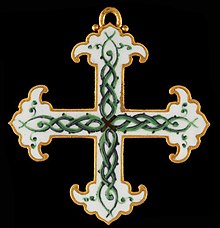Society for the Restoration of Orthodox Christianity in the Caucasus
Society for the Restoration of Orthodox Christianity in the Caucasus | |
 St. Nino orden - I | |
| Abbreviation | Russian: ОВПХК |
|---|---|
| Founder | Russian Empire |
| Type | Religion |
| Location | |
Region served | Caucasus |
Official language | Russian |
| Employees | (') |
The Society for the Restoration of Orthodox Christianity in the Caucasus (Russian: Общество Восстановления Православного Христианства на Кавказе) was a public organization in Russian Empire founded in 1860 to spread Eastern Orthodoxy in the Caucasus after it was conquered by Russian Empire in the 19th century.[1][2] It was dissolved in 1917.
History
As a Christian state, Russian Empire had already had the experience of converting the local population to Christianity, before the Russian conquest of Azerbaijan, across the states it conquered, especially, those inhabited by Moslems. From the mid-16th century, the Tsardom of Russia (under Tsar Ivan IV) aimed to pursue a foreign policy of conquering new territories and Christianizing indigenous people throughout these territories. During the invasion of the khanates of Kazan (1552) and Astrakhan (1556), as well as Siberia, Russia consolidated power in these occupied territories, using that exact method of Christianizing the locals and exploiting religious divisions.[3]
The policy of evangelizing the locals from the Jar-Balakan Community and the Elisu Sultanate was carried out by means of the same methods as those used for the locals across Kazan, Astrakhan and Siberia. There were only two differences here:
- The original intent was to evangelize Ingiloys, not the entire population of the Jar-Balakan communities.
- The Georgian Church played the role of the Russian Orthodox Church in spreading Christianity to Azerbaijan.
On August 18, 1851, Major-General Knyaz Mukhransky who served as the assistant chief of Zagatala province proposed that Ingiloys be exempted from taxes and duties in exchange for the conversion to Christianity, and that each Ingiloy family be rewarded with 15 -30 rubles in silver. This proposal was immediately welcomed by the tsarist authorities. On November 7, 1851, the Caucasian Viceroy (namestnik) Mikhail Vorontsov issued a special order to exempt the Ingiloys to be Christianized from the life and fireplace taxes they had to pay to the state treasury. In 1851, it was consequently possible to convert 1,133 Ingiloys to Christianity in Jar-Balakan. As a result of this Christianization policy, Gakh, Goragan, Meshabash, Kotuklu, and Alibeyli, which were once part of the Elisu Sultanate, were the first Christianized (orthodoxized) villages inhabited by Ingiloys.[4] The locals from the villages of Suskend and Shotavar refused to be Christianized. Soon, first churches were built in Gakh and Goragan.[3]
How the Society was founded
With Russian Empire complete invasion of the Caucasus, in 1860, the Society for the Restoration of Orthodox Christianity in the Caucasus was established to spread Christianity throughout the Caucasus by the initiative of the Exarch of Georgia and Metropolitan Isidore of Kartli-Kakheti and through the efforts of the Viceroy of the Caucasus Prince Alexander Ivanovich Baryatinsky. The Society, founded by order of Russia's Tsar on June 9, 1860, was patronized by Empress of Russia Maria Alexandrovna herself. During its activity, the Society had spent 1.475.482 rubles to spread Christianity to the Caucasus, including Northwest Azerbaijan. It was headquartered in Tbilisi.[1]
The core duties of the Society was to build and maintain churches, to carry servants, to open new schools for local children, to compile alphabets of local languages, to translate religious books into local languages, and to train priests or missioners elected from amongst locals.
In order to run the Society, firstly, a central office and temporary management committee was set up in Tbilisi. The Temporary Committee reserved the right to make decisions on which provinces of the Caucasus, and how, to function. Prince Alexander Baryatinsky, Exarch of Georgia archbishop Eusebius member of the governorship board A. Fadeyev and member of the state council Insarsky were elected as members of the committee. In 1861, Archpriest Ioakim Romanov was also elected as a member.[5]
Churches built in Azerbaijan
References
- ^ a b М. В. Клычникова, Е. А. Савенко (2010). "День утверждения устава Общества восстановления православного христианства на Кавказе" (in Russian). skunb.ru. Archived from the original on July 25, 2017.
- ^ "The Russian Empire's migration policy in the Caucasus". karabakh.org. Archived from the original on November 25, 2020.
- ^ a b Pasha Yagub (June 25, 2016). "Zaqatalada üsyan başlandı" (in Azerbaijani). moderator.az. Archived from the original on April 11, 2019.
- ^ Manana Gnolidze (August 16, 2010). "Activity of the Russian Orthodox Church Among the Muslim Natives of Caucasus in Imperial Russia". matiane.wordpress.com. Archived from the original on August 24, 2010.
- ^ А.Л. Цимцба (February 27, 2009). "Общество восстановления православного христианства на Кавказе. Цели, задачи, условия образования" (in Russian). slavakubani.ru. Archived from the original on April 11, 2019.
